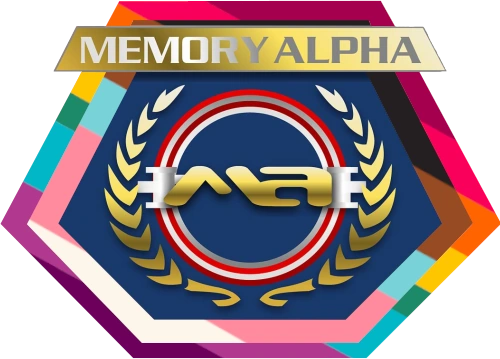 |
Warning! This page contains information regarding Star Trek: Prodigy, and thus may contain spoilers.
|
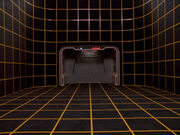
An inactive Federation holodeck, pre-2371
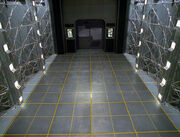
An inactive Federation holodeck, post-2371
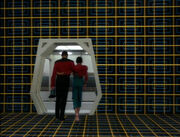
An alternate holodeck design
A holographic environment simulator, or holodeck as it was most commonly referred to, was a holographic simulation room, which was a form of holotechnology designed and used by the Federation Starfleet which ran holographic programs. They were installed aboard starships, space stations, and at Starfleet institutions during the mid-24th century for use in entertainment, training, and investigative purposes. (TNG: "Encounter at Farpoint")
History[]
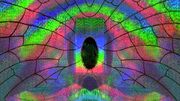
A 22nd century Xyrillian holo-chamber

Captain Lorca and Lieutenant Tyler exiting a holographic combat simulation
Prior to the late 24th century, Federation starships were not equipped with holodecks. (VOY: "Flashback")
In 2151, the Starfleet vessel Enterprise NX-01 encountered a vessel belonging to an alien race known as Xyrillians, who had advanced holographic technology in the form of a holographic chamber, or holo-chamber for short, which was similar to the holodeck technology commonly used by Starfleet two centuries later. (ENT: "Unexpected")
A holo-chamber was later installed aboard a Klingon battle cruiser after an encounter with a Xyrillian vessel discovered "hitchhiking" behind their ship. (ENT: "Unexpected")
In the 23rd century, the Crossfield-class vessel USS Discovery was equipped with holographic technology including holographic communications and combat training simulations. (DIS: "Lethe")
The recreation room aboard Constitution-class starships employed holographic technology. The USS Enterprise had a recreation room located in Area 39 of the ship. (TAS: "The Practical Joker")
By 2364, the Federation Starfleet was already installing holodecks aboard their vessels. (TNG: "Encounter at Farpoint")
During the 2360s and 2370s, a starship could have one or more holodecks depending on the vessel's size or purpose. For example, the compact Defiant-class USS Defiant did not have a holodeck while the larger Galaxy-class USS Enterprise-D had at least seven. (TNG: "The Perfect Mate")
In 2366, Data and Deanna Troi brought Lal to the holodeck in order to choose an appearance. (TNG: "The Offspring")
The Intrepid-class USS Voyager had at least two holodecks. The holodecks on Voyager were the only places other than sickbay where The Doctor was able to exist (prior to obtaining his mobile emitter) after his program was modified by the crew so he wasn't so tightly tied into the sickbay's systems. (VOY: "Night", "Heroes and Demons")
B'Elanna Torres used the Voyager's holodeck for a holographic orbital skydiving session. (VOY: "Extreme Risk")
Prometheus-class starships were equipped with holoemitters on every deck to allow an EMH a higher level of access and free movement around the ship. (VOY: "Message in a Bottle")
The USS Dauntless was equipped with holodecks. The status of the holodecks, and other areas, of the ship were reported on the master situation display. (PRO: "Mindwalk")
A clear view of the MSD was provided by Dominique Rossier of Wardenlight Studio. [1]
The location of the holodeck in the USS Voyager-A was labeled in the ship's master systems display. (PRO: "Into the Breach, Part I")
A clear view of the MSD was provided by Dominique Rossier of Wardenlight Studio. [2]
Purpose[]
The most obvious function of a holodeck was to provide entertainment and diversion for a starship's crew, as they typically spent months or years on missions. Entertainment could come in many forms, with personnel able to compose their own holo programs. Users could, for example, frequent a bar, become a character in a holo-novel, engage in extreme sports, and date and have sex with holographic characters. (TNG: "11001001", "The Big Goodbye", "Elementary, Dear Data", "A Fistful of Datas", "The Perfect Mate"; VOY: "The Cloud", "Blood Fever", "Homestead", "Fair Haven", "Extreme Risk", "Body and Soul", "Cathexis", "Night"; LD: "Moist Vessel")
A holodeck could be used to create training simulations and exercise environments not otherwise available or safe, including starship battle simulations, physical and combat simulations, the Bridge Officer's Test and the Kobayashi Maru scenario. (TNG: "Code of Honor", "Where Silence Has Lease", "The Emissary", "New Ground", "Thine Own Self", "Firstborn"; VOY: "Learning Curve", "Extreme Risk", "The Fight"; LD: "Terminal Provocations"; PRO: "Kobayashi")
The holodeck (or holographic research lab) could be used as a laboratory to aid in analysis, such as recreating the scene of a crime or accident to aid in forensic investigations. (TNG: "A Matter of Perspective"; VOY: "Repression") They could be used to visualize a 3D scene from alternate data sources for analysis, (TNG: "Identity Crisis", "Phantasms"; VOY: "Distant Origin") or used as a brainstorming tool. (TNG: "Schisms", "Booby Trap", "The Offspring")
The holodeck could also be used to test a person's beliefs or motives by creating a program to trick them into revealing their actions. (DS9: "Inquisition")
Design[]
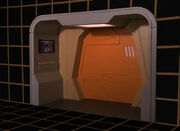
The arch in an inactive holodeck, pre-2371
A typical holodeck consisted of a room equipped with a hologrid containing omnidirectional holographic diodes, enabling holographic projections and holograms. Elements of transporter technology and replicators were used to create holodeck matter by the manipulation of photons contained within force fields to give objects the illusion of substance as well as actual matter. This matter could exist outside of the holodeck for brief periods of time (such as snow) before they would lose cohesion and revert back to energy without the support of the hologrid. (TNG: "Encounter at Farpoint", "The Big Goodbye", "Elementary, Dear Data") Holodecks were powered by holodeck reactors. (VOY: "Parallax") They were also equipped with biofilters which had to be periodically removed and emptied of waste matter. As removing the filter could momentarily expel a cloud of odorous gas, this was generally considered a highly undesirable task. (LD: "Moist Vessel")
Holodecks had databases to store programs, holograms, and holographic templates. (VOY: "Renaissance Man") A holobuffer stored complex holograms when inactive. (VOY: "Lifesigns", "Latent Image", "Inside Man") Due to the ability to store highly complex energy patterns, it was possible in some cases to store a person's physical parameters from his or her transporter pattern in the holodeck database. This could, in turn, be available for use in creation of holograms. (DS9: "Our Man Bashir") While viewing programs, a user could delete holocharacters using character deletion algorithms. (DS9: "Badda-Bing, Badda-Bang")
Holodecks had general systems and modes of operation that were used in holographic programs. They employed spatial orientation systems to simulate parts of a holocharacter, such as left- or right-handedness. (TNG: "Ship In A Bottle") Holodecks could also have a program element called a perceptual filter to hide anachronisms to the program's time period, such as uniforms and communicators, in order to prevent them from raising the character's ire and curiosity. (VOY: "Spirit Folk") Among the viewing modes on a holodeck was objective mode, in which the user didn't interact with the characters, and subjective mode, in which the viewer could interact with the characters as well as alter his or her surroundings. (ENT: "These Are the Voyages...") Holodecks could be equipped to change gravity in three dimensions. (VOY: "Extreme Risk")
The holodeck could be controlled from an exterior control panel, the interior arch control, or through bridge control relays in some designs. The arch could be summoned at any time to change the parameters of a running holoprogram. Matter and energy were interchangeable as such objects created on the holodeck could be either matter or energy. (TNG: "Elementary, Dear Data"; VOY: "Heroes and Demons", "The Killing Game"; Star Trek: Insurrection) Holodecks included components such as bi-converter interfaces. (TNG: "The Big Goodbye")
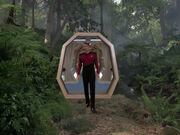
William T. Riker entering a holodeck simulation in 2364
When a user experienced a holographic environment, the holodeck walls could generate holographic images that appeared to extend for an unlimited distance, seemingly much larger than its own dimensions. The walls could be revealed if someone took an unexpected action in the program which hit the wall, for example if a person were to throw a holographic rock at the walls and the program was not able to react to show the rock continuing into the holographic image it created. (TNG: "Encounter at Farpoint")
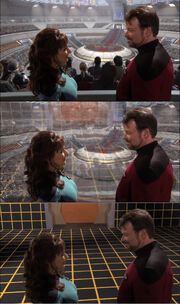
A holodeck program in the process of shutting down
Holodecks were equipped with safety protocols to prevent serious injury during their use, though these could be disengaged by the user when required. When protocols were deactivated, holographic obstacles had the same effects on a person as the objects or instances they simulated; holographic bullets or a steep drop could be fatal in such a scenario. (TNG: "The Big Goodbye"; Star Trek: First Contact; VOY: "Extreme Risk")
How the security protocols were circumvented differed; in one instance, it required the voice authorization of two senior officers, (TNG: "Descent") while in others the authorization of the individual such as the ship's captain, or the person who started the program was enough. (VOY: "Extreme Risk") Safety protocols could also be unintentionally disabled due to software errors or physical damage to the holodeck's hardware system. The status of safety protocols could be reviewed by the computer upon the request of an operator. A tricorder could also be used within the holodeck to query the current safety protocol status.
While it was noted by Geordi La Forge that there was no specific prohibition against creating images of people that existed in reality, some people such as Commander William Riker and Leah Brahms would take offense to people doing so. Lieutenant Barclay apparently had no problem creating holograms of the Enteprise D's crew, while Quark did not have easy access to Major/Colonel Kira's image in a program to rent to one of his customers.
Abilities and limitations[]
By the 2370s, holodeck technology was able to have fine enough control over magnetic containment fields that holographic objects could interact with matter on a biologically small level, for example, in replacing a person's organ with a simulated one that mimicked its functionality. (VOY: "Phage")
The computer used large magnetic bubbles to simulate surfaces and textures rather than creating an object at the molecular level. However, objects created within the holodeck did not exist beyond the holodeck itself, as they only existed as energy. (TNG: "The Big Goodbye") Holodecks also had access to extensive databases and archives and could recreate most historical scenes nearly exactly as they had occurred according to official records. This included material sometimes down to the smallest details, such as casual conversations by random people in public places, although in certain recreations the character names and appearances were slightly changed. (TNG: "We'll Always Have Paris")
Since holodeck technology could be used with replicator technology, there were some instances where real objects were replicated within the holodeck and used to interact with the holographic program and/or users for a more realistic experience; since these objects were real material composed of matter, they could leave the holodeck fully intact. Examples of this include Wesley Crusher still being wet after leaving the holodeck after falling into replicated water, (TNG: "Encounter at Farpoint") Lieutenant Commander Data being able to take a drawing of the Enterprise on a piece of paper out into the hallway, (TNG: "Elementary, Dear Data") and a wayward snowball being able to pass through the holodeck doors and strike Captain Picard. (TNG: "Angel One") Scents were also simulated in this way.
A holodeck could also modify the appearance of persons within it.
- The holoprogram depicting the final mission of the NX-class starship Enterprise NX-01 could project uniforms suitable to the participants' role over them. (ENT: "These Are the Voyages...")
- A holodeck was able to superimpose an entirely different appearance over a participant. (TNG: "The Offspring")
- Tom Paris' holoprogram Captain Proton existed as a monochromatic environment. (VOY: "Night", "Bride of Chaotica!")
- As part of The Big Good-Bye, appropriate attire could be projected over participants of the program. (Star Trek: First Contact)
- Simulations could also be projected inside living organisms, including that of pregnancy. (VOY: "The Killing Game")
- B'Elanna Torres' leg appeared to dematerialize while she was participating in the holonovel Photons Be Free as the holographic main character. (VOY: "Author, Author")
- Seven of Nine used the holodeck to hide her cybernetic implants. (VOY: "Human Error")
Holograms could be augmented with force beams to simulate solid, tangible objects or with replicator technology to create actual solid matter such as foodstuffs. All food eaten on the holodeck were replications. No other type of simulation could survive outside of the holodeck. (citation needed • edit)
A holodeck also had the ability to create holodecks within holodecks, and holodeck programs were able to be saved to a tech cube that could be inserted into an enhancement module to form an optronic data core with information to "last a lifetime." (TNG: "Ship In A Bottle")
The holodeck reactor, which powered the holodeck on 24th century Federation starships like Voyager, was incompatible with other ship systems. (VOY: "Parallax")
Failure of a holodeck's matter conversion subsystem could cause the loss of solid objects within the holodeck environment. Materialization errors occurred in the USS Enterprise-D holodecks in 2370 following the ship's exposure to plasmonic energy in the atmosphere of the planet Boraal II. (TNG: "Homeward")
Even though holographically created characters, just like characters in a story book, were never self-aware and never knew that they were not real, there were a few rare instances in which that rule did not hold true. During a Sherlock Holmes holodeck simulation in the late 2360s, Geordi La Forge and Doctor Katherine Pulaski argued that playing with Data was impossible and unfair to them as he had memorized all the Sherlock Holmes novels and could easily solve the cases. In order to level the playing field, La Forge requested that the holodeck create an opponent intelligent enough to defeat Data.
Even though La Forge meant Holmes, his request had specifically noted Data. As a result, the holodeck created a self-aware holographic character of James Moriarty who was not only fully aware of his own consciousness, but who subsequently argued that he had a right to exist and leave the holodeck to pursue his life as he wished. (TNG: "Elementary, Dear Data", "Ship In A Bottle") Another holographic writer, known as Felix, created the fully self-aware program of Vic Fontaine for the crew of Deep Space 9, Vic being completely aware of his holographic nature despite being a 1960s lounge singer, often offering the crew personal advice on relationship issues. (DS9: "His Way", "Badda-Bing, Badda-Bang", "It's Only a Paper Moon")
Holoprograms[]

The brig Enterprise holoprogram
Starships with a holodeck normally had a vast list of holoprograms in their computer. Several notable programs aboard the USS Enterprise-D included:
- A woodland setting, resembling Earth, which featured rock-jumping challenges, some of which were seemingly impossible to complete. (TNG: "Encounter at Farpoint")
- A New Orleans jazz nightclub. (TNG: "11001001")
- A recreation of the voyage on the Orient Express. (TNG: "Emergence")
- Sherlock Holmes mysteries, in which the user assumed the role of Sherlock Holmes and/or Dr. Watson (TNG: "Elementary, Dear Data", "Ship In A Bottle")
- Prospero's island, decor for Shakespeare's The Tempest. (TNG: "Emergence")
- The Valley of Chula on Romulus (TNG: "The Defector")
- Café des Artistes – "Enjoy a meal at a French cafe." (TNG: "We'll Always Have Paris")
- Charnock's Comedy Cabaret – "Laugh in a 20th century comedy club." (TNG: "The Outrageous Okona")
- The Big Good-Bye – "The 1940s world of gumshoe detective Dixon Hill." (TNG: "The Big Goodbye", "Manhunt", "Clues")
- Cliffs of Heaven – "From planet Sumiko IV, a safe experience." (TNG: "Conundrum")
- Equestrian Adventure – "Horse riding in an open country..." (TNG: "Pen Pals")
- Karate Dojo – Shown by Tasha Yar to the Ligonians before she was kidnapped. (TNG: "Code of Honor")
- Lieutenant Worf's Klingon calisthenics program – a swamp-like setting in which various alien enemies tested ones fighting skill. (TNG: "Where Silence Has Lease", "The Emissary", "New Ground")
- The bridge of the USS Enterprise – the user could select any of the five (at the time) bridges of the various Federation starships named Enterprise to view. Captain Montgomery Scott only wanted to see the original Enterprise bridge, "no bloody A, B, C, or D." (TNG: "Relics")
- The Final Mission of Enterprise – this program allowed a user to view or take part in the final mission of the NX-01 Enterprise, commanded by Captain Jonathan Archer, as well as showcasing the signing of the Federation Charter. (ENT: "These Are the Voyages...")
- Natasha Yar's Living Will – designed by Lieutenant Natasha Yar to be played in the event she was killed, where she bid farewell to her comrades. The Enterprise bridge crew unfortunately had to watch the program when Yar was killed by Armus on Vagra II. (TNG: "Skin Of Evil")
- Celtris III Underground – a simulation in which the users could prepare for missions on the Cardassian planet of Celtris III. (TNG: "Chain Of Command, Part I")
- Lieutenant Barclay's various programs – these included a mock-up of Ten Forward, in which the user could attack Commander Riker and Lt. Commander Geordi La Forge to "blow off some steam" as well as win the heart of Deanna Troi; a mock-up of Counselor Troi's office in which the user could receive counseling from a hologram rather than the real Troi; a woodland setting in which the user could duel with recreations of Captain Picard, Data, and La Forge in a sword fight, complete with a recreation of Deanna Troi as "The Goddess of Empathy"; a mock-up of the Enterprise-D bridge, in which the user could bid farewell to the bridge crew; the Einstein program in which the user could debate mathematics and science with Albert Einstein; a synaptic interface in which the user could control the main computer of the Enterprise with the power of their own thoughts (however, removal of the user by conventional means would result in death); and various other programs. (TNG: "Hollow Pursuits", "The Nth Degree")
- A game of poker with three famous scientific minds: Albert Einstein, Sir Isaac Newton, and Stephen Hawking. (TNG: "Descent")
- USS Enterprise – an 18th century Earth brig. (Star Trek Generations)
Notable programs aboard the USS Enterprise-E included:
- The Big Good-Bye – "The 1940s world of gumshoe detective Dixon Hill." (Star Trek: First Contact)
- Café des Artistes – "Enjoy a meal at a French cafe." (Star Trek: First Contact)
- Champs Elysees – "Famous section of Paris." (Star Trek: First Contact)
- Charnock's Comedy Cabaret – "Laugh in a 20th century comedy club." (Star Trek: First Contact)
- Emerald Wading Pool – "From planet Sumiko III, a safe experience." (Star Trek: First Contact)
- Equestrian Adventure – "Horse riding in an open countryside with a choice of..." (Star Trek: First Contact)
Notable programs aboard the USS Voyager included:
- Chez Sandrine (VOY: "The Cloud")
- Janeway Lambda One (VOY: "Learning Curve")
- Paxau Resort (VOY: "Warlord")
- Insurrection Alpha (VOY: "Worst Case Scenario")
- Leonardo da Vinci's workshop (VOY: "Scorpion")
- The Adventures of Flotter (VOY: "Once Upon a Time")
- Velocity (VOY: "Hope and Fear")
- The Adventures of Captain Proton (VOY: "Night")
- Fair Haven (VOY: "Fair Haven")
- Photons Be Free (VOY: "Author, Author")
- Holographic family (VOY: "Real Life")
Notable programs aboard the USS Protostar included:
- Andoria IV (PRO: "Kobayashi")
- Ceti Alpha V (PRO: "Kobayashi")
- kal-if-fee gladiatorial match (PRO: "Kobayashi")
- Count Dracula (PRO: "Kobayashi")
- Janeway Lambda One (PRO: "Kobayashi")
- Deadwood, South Dakota (PRO: "Kobayashi")
- Paxau Resort (PRO: "Kobayashi")
- Kobayashi Maru scenario (PRO: "Kobayashi")
- Fox, chicken and grain problem (PRO: "Time Amok")
Notable programs aboard the USS Enterprise's recreation room included:
- A beach setting allowing for swimming.
- A woodland environment allowing for a nature walk.
- An arctic wasteland.
- An 18th century style hedge maze. (TAS: "The Practical Joker")
Appendices[]
Appearances[]
- TAS:
- "The Practical Joker" (Season 2)
- TNG:
- "Encounter at Farpoint" (Pilot, Season 1)
- "Code of Honor"
- "Haven"
- "The Big Goodbye"
- "11001001"
- "Coming of Age"
- "Skin Of Evil"
- "We'll Always Have Paris"
- "Where Silence Has Lease" (Season 2)
- "Elementary, Dear Data"
- "The Dauphin"
- "The Icarus Factor"
- "Pen Pals"
- "Manhunt"
- "The Emissary"
- "Shades of Gray" (recycled footage)
- "Booby Trap" (Season 3)
- "The Defector"
- "A Matter of Perspective"
- "The Offspring"
- "Hollow Pursuits"
- "Family" (Season 4)
- "Future Imperfect"
- "Data's Day"
- "Devil's Due"
- "Clues"
- "Galaxy's Child"
- "Identity Crisis"
- "The Nth Degree"
- "New Ground" (Season 5)
- "Cost Of Living"
- "The Perfect Mate"
- "Relics" (Season 6)
- "Schisms"
- "A Fistful of Datas"
- "Chain Of Command, Part I"
- "Ship In A Bottle"
- "Rightful Heir"
- "Descent"
- "Phantasms" (Season 7)
- "Inheritance"
- "Homeward"
- "Thine Own Self"
- "Firstborn"
- "Bloodlines"
- "Emergence"
- "All Good Things..."
- DS9:
- "Emissary" (Season 1)
- "Inquisition" (Season 6)
- Star Trek films
- VOY:
- "The Cloud" (Season 1)
- "Heroes and Demons"
- "Cathexis"
- "Jetrel"
- "Learning Curve"
- "Projections" (Season 2)
- "Twisted"
- "Parturition"
- "Persistence of Vision"
- "Threshold"
- "Meld"
- "Lifesigns"
- "Tuvix"
- "The Swarm" (Season 3)
- "Warlord"
- "The Q and the Grey"
- "Macrocosm"
- "Alter Ego"
- "Blood Fever"
- "Darkling"
- "Before and After"
- "Real Life"
- "Distant Origin"
- "Displaced"
- "Worst Case Scenario"
- "Scorpion"
- "Scorpion, Part II" (Season 4)
- "Day of Honor"
- "The Raven"
- "Scientific Method"
- "Concerning Flight"
- "Mortal Coil"
- "The Killing Game"
- "The Killing Game, Part II"
- "Vis à Vis"
- "The Omega Directive"
- "One"
- "Hope and Fear"
- "Night" (Season 5)
- "Extreme Risk"
- "Once Upon a Time"
- "Timeless"
- "Nothing Human"
- "Thirty Days"
- "Latent Image"
- "Bride of Chaotica!"
- "Dark Frontier"
- "The Fight"
- "Someone to Watch Over Me"
- "Tinker Tenor Doctor Spy" (Season 6)
- "Pathfinder"
- "Fair Haven"
- "Spirit Folk"
- "Life Line"
- "Imperfection" (Season 7)
- "Repression"
- "Inside Man"
- "Body and Soul"
- "Flesh and Blood"
- "Shattered"
- "Lineage"
- "Prophecy"
- "Human Error"
- "Q2"
- "Author, Author"
- "Renaissance Man"
- ENT:
- "These Are the Voyages..." (Season 4)
- DIS:
- "Lethe" (Season 1)
- LD:
- "Second Contact" (Season 1)
- "Moist Vessel"
- "Terminal Provocations"
- "Crisis Point"
- "wej Duj" (Season 2)
- "Room for Growth" (Season 3)
- "Crisis Point 2: Paradoxus"
- "Twovix" (Season 4)
- "I Have No Bones Yet I Must Flee"
- "Something Borrowed, Something Green"
- "Old Friends, New Planets"
- PRO:
- "Kobayashi" (Season 1)
- "Time Amok"
- "A Moral Star, Part 2"
- "Asylum"
- "Let Sleeping Borg Lie"
- "Ghost in the Machine"
- PIC:
- "No Win Scenario" (Season 3)
- "Imposters"
- "The Bounty"
Additional references[]
- TNG:
- "The Measure Of A Man" (Season 2)
- "Evolution" (Season 3)
- "Captain's Holiday"
- "The Loss" (Season 4)
- "The Game" (Season 5)
- "Conundrum"
- "Imaginary Friend"
- "Man Of The People" (Season 6)
- "Liaisons" (Season 7)
- DS9:
- "The Way of the Warrior" (Season 4)
- VOY:
- "Parallax" (Season 1)
- "Prime Factors"
- "Non Sequitur" (Season 2)
- "Investigations"
- "Deadlock"
- "The Thaw"
- "Basics, Part I"
- "Flashback" (Season 3)
- "Remember"
- "Future's End"
- "Unity"
- "Rise"
- "Revulsion" (Season 4)
- "Waking Moments"
- "Message in a Bottle"
- "Living Witness"
- "Demon"
- "Relativity" (Season 5)
- "Equinox"
- "Equinox, Part II" (Season 6)
- "Alice"
- "Riddles"
- "Ashes to Ashes"
- "Live Fast and Prosper"
- "Fury"
- "Drive" (Season 7)
- "Critical Care"
- "Nightingale"
- "Friendship One"
- "Homestead"
- "Endgame"
- DIS:
- "All In"
Background information[]
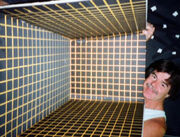
Dennis Hoerter with a holodeck model at Image G
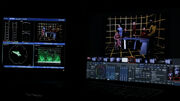
The remastering of a holodeck scene from "A Matter of Perspective"
The concept of the holodeck originated in 1968, when Gene Roddenberry came up with the idea of a "simulated outdoor recreation area" on the Enterprise for the third season of Star Trek: The Original Series. This idea never came to fruition, probably because of budget constraints. (Inside Star Trek: The Real Story, p. 404) The idea was later used in the Star Trek: The Animated Series episode "The Practical Joker", which was basically the first appearance of the holodeck, then called a "recreation room". It came to existence in live-action production in the pilot of Star Trek: The Next Generation. Its inclusion in that series was originally proposed by Robert H. Justman, who initially thought of and suggested it as a place where crew members could be "psychically connected" with their homeworld. (Starlog issue 115, p. 71)
In early episodes of TNG, the series' production staff had an unwritten rule that the floors in a holodeck simulation shouldn't go below the floor level of the holodeck's door. This made sense, as burrowing down to the deck below would probably be inadvisable on a starship. Subsequent story requirements and set designs eventually influenced producers to alter their "rule," deciding that at least one holodeck was a multi-story chamber. (text commentary, Star Trek Generations (Special Edition) DVD)
The appearance of the holodeck on TNG was affected by having limited finances. Production Designer Herman Zimmerman commented, "We were in a budget constraint that made us do a set that is a wireframe look." Zimmerman and other members of the design team that worked on TNG had a long-standing interest in demonstrating the machinery of the holodeck from inside the room, though this was not made possible until the advent of the Cardassian holosuite in Star Trek: Deep Space Nine. (The Deep Space Log Book: A Second Season Companion)
Despite the fact that the Galaxy-class starship was meant to have numerous holodecks, a single set represented these environments on TNG. This was one of the last sets to be built for the show and was also used to represent the Galaxy-class cargo bays, shuttlebays, and gymnasium. (Star Trek: The Next Generation Companion, 3rd ed., p. 10)
The holodeck arch was a prop that was originally made for TNG: "Haven". Although some holodeck programs incorporated the arch to make the task of finding the way out easier, the arch originated as a way to let outsiders know when it was safe or appropriate to enter. (text commentary, Star Trek Generations (Special Edition) DVD) The same arch set piece was featured in both TNG and the film Star Trek Generations. (Cinefex, No. 61, p. 69)
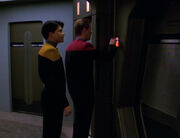
The exterior of an Intrepid-class holodeck, mid-2371
For its first appearance on Star Trek: Voyager in "The Cloud", the exterior of the holodeck was the same set piece as had previously been seen on TNG, right down to the octagonal door frame, although all had been repainted to match the color scheme for the new Voyager corridors. It did not receive a square door arch and updated door panels until its second appearance.
There are many discrepancies between episodes pertaining to the abilities and limits of holodeck technology. For example, in "Encounter at Farpoint", the young Wesley Crusher remains wet with holodeck water, after exiting into a corridor. In "Elementary, Dear Data", a piece of paper given to Data by James Moriarty is able to be carried outside of the holodeck and into a hall, but upon Moriarty's return in "Ship In A Bottle", a book thrown outside of the holodeck instantly disappears.
Also, in "The Big Goodbye", Cyrus Redblock and Felix Leech disappear slowly after a few moments outside of the holodeck, although a lipstick smudge from a holographic character stays with Picard all the way onto the bridge. Although these inconsistencies can be partially explained by the difference in the types of objects leaving the holodeck, it still leaves quite a few questions about what exactly constitutes the differences. The holodeck can use a degree of replication to make realistic objects for the holodeck occupant to use, so there is a possibility of the computer replicating a real piece of paper with the picture on, as it would be a relatively simple pattern.
Some may argue that another discrepancy is the need for holodeck users to change into the appropriate costumes before entering and leaving the holodeck, since the holodeck has the ability to change the appearance of its users (established in ENT: "These Are the Voyages..."). But this may just be an issue of taste, on the user's possible preference of replicated clothes versus holographic clothes. Another theory is that the settings of the holodeck can be altered to not only make weapons be lethal as seen in Star Trek: First Contact in which Picard kills the Borg in a ballroom suite with a machine gun but also to make what events transpired inside it real life like the aforementioned lipstick smudge on Picard
Actor Robert O'Reilly once remarked that, when he appeared as Scarface in TNG: "Manhunt", he "really didn't understand the holodeck." (The Official Star Trek: Deep Space Nine Magazine issue 16, p. 24)
Ultimately, it is evident to longtime viewers of the Star Trek franchise that the holodeck is a storytelling device, like many other aspects of the shows, and only behaves consistently within narrative bounds.
From the Star Trek Encyclopedia, 4th ed., vol. 1, p. 344, "Star Trek writer-producer Ronald D. Moore argued that in a free society of responsible citizens, there should be little or no limit on what an adult can do in a holodeck. Even if others might find certain activities objectionable, what one does in one's private space is no one's business; certainly not the government's. Of the argument that certain activities should be prohibited on the grounds that they might be harmful or addictive to a holodeck participant, Moore suggested that in a free society, a responsible adult must be permitted to judge risks to his or her own well-being, and to act accordingly. Moore conceded that there might well be circumstances in which someone might object to being replicated on a holodeck, but notes that it would be extremely difficult to define legally what constituted fair use and what was abusive. (Moore emphasized that he referred to holodeck usage by adults, not by children.)"
The holodeck is one of the prominent examples of Star Trek predicting technology, like VR, MR, and AR.
See also[]
- Computer-generated imagery
- Federation holoship
- Holoprogram
- Holosuite
- Holotechnology
- Synaptic stimulator
- Visual simulator
External links[]
- Holodeck at Memory Beta, the wiki for licensed Star Trek works
- Holodeck at Wikipedia

